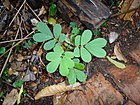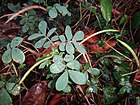Note: This is a project under development. The articles on this wiki are just being initiated and broadly incomplete. You can Help creating new pages.
Difference between revisions of "Cassia tora"
(Created page with "{{stub}} ==Uses== {{Uses|}}, {{Uses|}}, {{Uses|}}, {{Uses|}}, {{Uses|}}, {{Uses|}}, {{Uses|}}, {{Uses|}}, {{Uses|}}, {{Uses|}}, {{Uses|}}. ==Parts Used== {{Parts Used|}}, {{...") |
|||
| (6 intermediate revisions by the same user not shown) | |||
| Line 1: | Line 1: | ||
| − | + | [[File:Cassia Tora (young plant).JPG|thumb|right]] | |
| − | + | '''Cassia tora''' is an annual to perennial plant. It can grow up to 2 metres tall. The plant is gathered from the wild for local use as a food and medicine. It is sometimes cultivated for its seeds, which are used as a mordant. | |
==Uses== | ==Uses== | ||
| − | {{Uses|}}, {{Uses|}}, {{Uses|}}, {{Uses|}}, {{Uses|}}, {{Uses|}}, {{Uses|}}, {{Uses|}}, {{Uses| | + | {{Uses|Ringworm}}, {{Uses|Skin diseases}}, {{Uses|Vomiting}}, {{Uses|Stomachache}}, {{Uses|Skin infections}}, {{Uses|Sores}}, {{Uses|Ulcers}}, {{Uses|Insect bites}}, {{Uses|Eye complaints}}. |
==Parts Used== | ==Parts Used== | ||
| − | {{Parts Used| | + | {{Parts Used|Seeds}}. |
==Chemical Composition== | ==Chemical Composition== | ||
| Line 11: | Line 11: | ||
==Common names== | ==Common names== | ||
| − | {{Common names|sa=|en=|gu=|hi=|kn=|ks=|ml=|mr=|pa=|ta=|te=}} | + | {{Common names|sa=|en=Foetid cassia, Coffee pod|gu=|hi=|kn=Chagache|ks=|ml=|mr=|pa=|ta=|te=}} |
==Properties== | ==Properties== | ||
| Line 17: | Line 17: | ||
===Dravya=== | ===Dravya=== | ||
===Rasa=== | ===Rasa=== | ||
| − | |||
===Guna=== | ===Guna=== | ||
| Line 34: | Line 33: | ||
==Identification== | ==Identification== | ||
===Leaf=== | ===Leaf=== | ||
| − | {{Leaf|||}}<ref name="Leaf"/> | + | {{Leaf|Alternative pinnate|Leaflets with opposite pairs|Obovate in shape with a rounded tip, 3-3.5 cm log}}<ref name="Leaf"/> |
===Flower=== | ===Flower=== | ||
| − | {{Flower||||}} | + | {{Flower|||Yellow|Stamens are of unequal lenth}} |
===Fruit=== | ===Fruit=== | ||
| Line 49: | Line 48: | ||
==Mode of Propagation== | ==Mode of Propagation== | ||
| − | {{Propagation|}} | + | {{Propagation|Seeds}} |
==How to plant/cultivate== | ==How to plant/cultivate== | ||
| − | <ref name="How to plant/cultivate"/> | + | Plants succeed in the tropics and subtropics.<ref name="How to plant/cultivate"/> |
==Commonly seen growing in areas== | ==Commonly seen growing in areas== | ||
| − | {{Commonly seen|}}, {{Commonly seen|}}, {{Commonly seen|}}, {{Commonly seen|}}, {{Commonly seen|}} | + | {{Commonly seen|Waste ground}}, {{Commonly seen|Dry to wet thickets}}, {{Commonly seen|Cultivated ground}}, {{Commonly seen|Mountain slopes}}, {{Commonly seen|River bank sands}} |
==Photo Gallery== | ==Photo Gallery== | ||
<gallery class="left" caption="" widths="140px" heights="140px"> | <gallery class="left" caption="" widths="140px" heights="140px"> | ||
| − | + | File:Cassia Tora (young plant).JPG | |
| + | File:Cassia Tora (the seeds).JPG | ||
</gallery> | </gallery> | ||
| Line 65: | Line 65: | ||
<references> | <references> | ||
| − | <ref name="chemical composition">[ | + | <ref name="chemical composition">[Chemistry]</ref> |
| − | <ref name="Leaf"> | + | <ref name="Leaf">Kappatagudda - A Repertoire of Medicianal Plants of Gadag by Yashpal Kshirasagar and Sonal Vrishni, Page No. 115</ref> |
| − | <ref name="How to plant/cultivate">[ | + | <ref name="How to plant/cultivate">[http://tropical.theferns.info/viewtropical.php?id=Senna%20tora Cultivation]</ref> |
</references> | </references> | ||
==External Links== | ==External Links== | ||
| − | * [ ] | + | * [https://indiabiodiversity.org/species/show/32538 Cassia tora on Indiabiodiversity.org] |
| − | * [ ] | + | * [https://hort.purdue.edu/newcrop/CropFactSheets/cassia.html Cassia tora on Purdue.edu] |
| − | + | ||
[[Category:Herbs]] | [[Category:Herbs]] | ||
| + | [[Category:Pages without herbs images]] | ||
Latest revision as of 12:20, 28 April 2021
Cassia tora is an annual to perennial plant. It can grow up to 2 metres tall. The plant is gathered from the wild for local use as a food and medicine. It is sometimes cultivated for its seeds, which are used as a mordant.
Contents
- 1 Uses
- 2 Parts Used
- 3 Chemical Composition
- 4 Common names
- 5 Properties
- 6 Habit
- 7 Identification
- 8 List of Ayurvedic medicine in which the herb is used
- 9 Where to get the saplings
- 10 Mode of Propagation
- 11 How to plant/cultivate
- 12 Commonly seen growing in areas
- 13 Photo Gallery
- 14 References
- 15 External Links
Uses
Ringworm, Skin diseases, Vomiting, Stomachache, Skin infections, Sores, Ulcers, Insect bites, Eye complaints.
Parts Used
Chemical Composition
Common names
| Language | Common name |
|---|---|
| Kannada | Chagache |
| Hindi | |
| Malayalam | |
| Tamil | |
| Telugu | |
| Marathi | |
| Gujarathi | |
| Punjabi | |
| Kashmiri | |
| Sanskrit | |
| English | Foetid cassia, Coffee pod |
Properties
Reference: Dravya - Substance, Rasa - Taste, Guna - Qualities, Veerya - Potency, Vipaka - Post-digesion effect, Karma - Pharmacological activity, Prabhava - Therepeutics.
Dravya
Rasa
Guna
Veerya
Vipaka
Karma
Prabhava
Habit
[[:Category:Habit - |]]
Identification
Leaf
| Kind | Shape | Feature |
|---|---|---|
| Alternative pinnate | Leaflets with opposite pairs | Obovate in shape with a rounded tip, 3-3.5 cm log |
Flower
| Type | Size | Color and composition | Stamen | More information |
|---|---|---|---|---|
| Yellow | Stamens are of unequal lenth | {{{5}}} |
Fruit
| Type | Size | Mass | Appearance | Seeds | More information |
|---|---|---|---|---|---|
Other features
List of Ayurvedic medicine in which the herb is used
Where to get the saplings
Mode of Propagation
How to plant/cultivate
Plants succeed in the tropics and subtropics.[3]
Commonly seen growing in areas
Waste ground, Dry to wet thickets, Cultivated ground, Mountain slopes, River bank sands
Photo Gallery
References
- ↑ [Chemistry]
- ↑ Kappatagudda - A Repertoire of Medicianal Plants of Gadag by Yashpal Kshirasagar and Sonal Vrishni, Page No. 115
- ↑ Cultivation
External Links
- Ayurvedic Herbs known to be helpful to treat Ringworm
- Ayurvedic Herbs known to be helpful to treat Skin diseases
- Ayurvedic Herbs known to be helpful to treat Vomiting
- Ayurvedic Herbs known to be helpful to treat Stomachache
- Ayurvedic Herbs known to be helpful to treat Skin infections
- Ayurvedic Herbs known to be helpful to treat Sores
- Ayurvedic Herbs known to be helpful to treat Ulcers
- Ayurvedic Herbs known to be helpful to treat Insect bites
- Ayurvedic Herbs known to be helpful to treat Eye complaints
- Herbs with Seeds used in medicine
- Herbs with common name in Kannada
- Herbs with common name in English
- Habit -
- Index of Plants which can be propagated by Seeds
- Herbs that are commonly seen in the region of Waste ground
- Herbs that are commonly seen in the region of Dry to wet thickets
- Herbs that are commonly seen in the region of Cultivated ground
- Herbs that are commonly seen in the region of Mountain slopes
- Herbs that are commonly seen in the region of River bank sands
- Herbs
- Pages without herbs images


